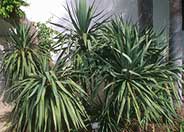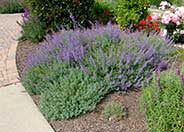
Common name:Spineless Yucca
Botanical name:Yucca recurvifolia
This evergreen shrub is part of the Agave family and reaches 6'-10' tall. It has distinctive blue gray leaves that bend sharply downward. It blooms with white flowers on 3'-5' tall spikes in late spring and early summer. Leaf tips have spines but they bend and do not cause injury.

Common name:Smooth-edged Agave
Botanical name:Agave weberi
This is a striking medium-sized Agave that can grow to 5' tall by 6'-10' wide. This agave has very fine marginal teeth and is sometimes spineless. Supplemental summer watering can prevent yellowing from heat stress in the summer. These plants are also moderately cold hardy and tolerant of temperatures down to 12 degrees F. It is more refined looking than americana. It is native in central Eastern Mexico. It is one of the largest of the Agaves.

Common name:Catmint
Botanical name:Nepeta X faassenii
Nepeta faassenii makes soft, gray green, undulating mounds that are 1.5' high when blooming. The small leaves are attractive to cats. This perennial has lavender blue flowers in late spring and early summer.

Common name:Verbena
Botanical name:Verbena peruviana
This perennial forms a flat mat that covers an area rapidly. It has dark green leaves with clusters of bright flowers that bloom all year. Hybrids will have a little more height, different flower colors and spread more slowly. It is drought tolerant.

Common name:Coast Live Oak
Botanical name:Quercus agrifolia
Coast Live Oak (Quercus agrifolia) is one of the best trees for California native or California-friendly gardens. It grows very well from the coastal areas to the interior valleys. It is an evergreen tree that can reach 25’-70' tall and up to 70' wide, so make sure you have the space in your garden to support it. It is considered very low-water-use and is susceptible to root rot in gardens that are over-irrigated. Plant it with other California natives or low-water plants and stick to a watering cycle that includes watering during the fall, winter, and spring with no supplemental water in the summer. The tree is a slow grower and has an irregular shape when it is young, so it is important to make minimal pruning cuts to improve the look of the canopy. Over-pruning or hedging can take years to recover from, so consult or hire a licensed arborist when the shaping becomes out of your reach. This tree will eventually become a large shade tree; therefore, the plant selection around it may need to be adjusted as it matures. This tree should be planted at least five feet away from any hardscape areas, 20 feet from structures such as houses and buildings, and not near any powerlines. Shrubs and perennials should be planted about four feet away from this tree. It should be irrigated for about 45 minutes once a week when using most in-line drip irrigation systems.

Common name:Bottlebrush Little John
Botanical name:Callistemon X viminalis 'Little John'
The 'Little John' exhibits very dense, compact growth to 3' x 3'. It produces clusters of blood red flowers and grey green foliage. A very regular, almost symmetrical, spiral patten of dense oval leaves is shown along the stems.

Common name:Trailing Ice Plant
Botanical name:Lampranthus spectabilis
This succulent groundcover is a moderately fast grower, spreading 2' wide and mounding and can grow 6"-12" tall. During the spring, it is covered with flowers could be shades of pink, purple or white. Leaves are gray green. This mounding succulent does best in full sun and is drought tolerant. It needs good drainage. It may need to be periodically cut back to rejuvenate the plant.
Designer: N/A
Photographer: GardenSoft
Maintain a two to four inch layer of mulch on the soil surface to reduce weeds, infiltrate rain water, and reduce compaction.
Be sure to fix all leaks promptly no matter how small they may seem.
Attract, or buy beneficial insects such as ladybugs and lacewings to control pest outbreaks in your garden.